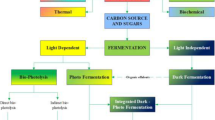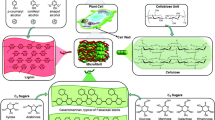Abstract
Hemicellulose liquid hydrolyzate from dilute acid pretreated corn stover was fermented to ethanol using Pichia stipitis CBS 6054. The fermentation rate increased with aeration but the pH also increased due to consumption of acetic acid by Pichia stipitis. Hemicellulose hydrolyzate containing 34 g/L xylose, 8 g/L glucose, 8 g/L Acetic acid, 0.73 g/L furfural, and 1 g/L hydroxymethyl furfural was fermented to 15 g/L ethanol in 72 h. The yield in all the hemicellulose hydrolyzates was 0.37–0.44 g ethanol/g (glucose + xylose). Nondetoxified hemicellulose hydrolyzate from dilute acid pretreated corn stover was fermented to ethanol with high yields, and this has the potential to improve the economics of the biomass to ethanol process.





Similar content being viewed by others

References
Zaldivar J, Nielsen J, Olsson L (2001) Fuel ethanol production from lignocellulose: a challenge for metabolic engineering and process integration. Appl Microbiol Biotechnol 56:17–34
Chandrakant P, Bisaria VS (1998) Simultaneous conversion of cellulose and hemicellulose to ethanol. Crit Rev Biotechnol 18(4):295–331
Gray KA, Zhao L, Emptage M (2006) Bioethanol. Curr Opin Chem Biol 10:141–146
Kadam KL, McMillan JD (2003) Availability of corn stover as a sustainable feedstock for bioethanol production. Bioresour Technol 88:17–25
Schell DJ, Farmer J, Newman M, McMillan JD (2003) Dilute-sulphuric acid pretreatment of corn stover in pilot-scale reactor. Appl Biochem Biotechnol 105–108:69–85
Saha BC (2003) Hemicellulose bioconversion. J Ind Microbiol Biotechnol 30:279–291
Chang VS, Holtzapple MT (2000) Fundamental factors affecting biomass enzymatic reactivity. Appl Biochem Biotechnol 84:5–38
Kim S, Holtzapple MT (2006) Effect of structural features on enzyme digestibility of corn stover. Bioresour Technol 97:583–591
Mosier N, Wyman C, Dale B, Elander R, Lee YY, Holtzapple M, Ladisch M (2005) Features of promising technologies for pretreatment of lignocellulosic biomass. Bioresour Technol 96:673–686
Tucker MP, Kim KH, Newman MM, Nguyen QA (2003) Effects of temperature and moisture on dilute-acid steam explosion pretreatment of corn stover and cellulose enzyme digestibility. Appl Biochem Biotechnol 105–108:165–177
Palmqvist E, Hahn-Hagerdal B (2000) Fermentation of lignocellulosic hydrolysates. II: Inhibitors and mechanisms of inhibition. Bioresour Technol 74:25–33
Liu ZL, Slininger PJ, Gorsick SW (2005) Enhanced biotransformation of furfural and hydroxymethylfurfural by newly developed ethanologenic yeast strains. Appl Biochem Biotechnol 121–124:451–460
Wyman CE (2003) Potential synergies and challenges in refining cellulosic biomass to fuels, chemicals, and power. Biotechnol Prog 19:254–262
Parekh S, Wayman M (1986) Fermentation of cellobiose and wood sugars to ethanol by Candida shehatae and Pichia stipitis. Biotechnol Lett 8:597–600
Schneider H, Wang PY, Chan YK, Maleszka R (1981) Conversion of d-xylose into ethanol by the yeast Pachysolen tannophilus. Biotechnol Lett 3:89–92
du Preez JC, Prior BA (1985) A quantitative screening of some xylose fermenting yeast isolates. Biotechnol Lett 7:241–248
Agbogbo FK, Coward-Kelly G, Torry-Smith M, Wenger KS (2006) Fermentation of glucose/xylose mixtures using Pichia stipitis. Process Biochem 41:2333–2336
Grootjen DRJ, van der Lans RGJM, Luyben KchAM (1990) Effects of the aeration rate on the fermentation of glucose and xylose by Pichia stipitis CBS 5773. Enzyme Microb Technol 12:20–23
Skoog K, Hahn-Hagerdal B (1990) Effect of oxygenation on xylose fermentation by Pichia stipitis. Appl Environ Microbiol 56(11):3389–3394
Klinner U, Fluthgraf S, Freese S, Passoth V (2005) Aerobic induction of respiro-fermentative growth by decreasing oxygen tensions in the respiratory yeast Pichia stipitis. Appl Microbiol Cell Physiol 67:247–253
Delgenes JP, Moletta R, Navarro JM (1986) The effect of aeration on d-xylose fermentation by Pachysolen tannophilus, Pichia stipitis, Kluyveromyces marxianus and Candida shehatae. Biotechnol Lett 8(12):897–900
Briunenberg PM, de Bot PHM, van Dijken JP, Scheffers WA (1984) NADH-linked aldose reductase: The key to anaerobic alcoholic fermentation of xylose by yeasts. Appl Microbiol Biotechnol 19:256–260
van Zyl C, Prior BA, du Preez JC (1988) Production of ethanol from sugar cane bagasse hemicellulose hydrolyzate by Pichia stipitis. Appl Biochem Biotechnol 357–369
Sreenath HK, Jeffries TW (2000) Production of ethanol from wood hydrolyzate by yeasts. Bioresour Technol 253–260
Tran AV, Chambers RP (1985) Red Oak wood derived inhibitors in the ethanol fermentation of xylose in Pichia stipitis CBS 5776. Biotechnol Lett 7(11):841–846
Liden G, Jacobsson V, Niklasson C (1993) The effect of carbon dioxide on xylose fermentation by Pichia stipitis. Appl Biochem Biotechnol 38:27–40
Agbogbo FK, Wenger KS (2006) The effect of pretreatment chemicals on xylose fermentation by Pichia stipitis. Biotechnol Lett 28:2065–2069
Slininger PA, Dien BS, Gorsick SW, Liu ZL (2006) Nitrogen source and mineral optimization enhances d-xylose conversion to ethanol by the yeast Pichia stipitis NRRL Y-7124. Appl Microbiol Cell Physiol 72:1285–1296
Acknowledgments
This investigation was supported by the Abengoa-DOE project. We like to thank Dr. Thomas Jeffries for generously providing the yeast strain, David Milam for analytical support on HPLC and Dr. K. C. McFarland for HMF and furfural analyses. We also like to thank Dr. Guillermo Coward-Kelly, Dr. Mads Torry-Smith and Dr. Frank D. Haagensen for useful discussions.
Author information
Authors and Affiliations
Corresponding author
Rights and permissions
About this article
Cite this article
Agbogbo, F.K., Wenger, K.S. Production of ethanol from corn stover hemicellulose hydrolyzate using Pichia stipitis . J Ind Microbiol Biotechnol 34, 723–727 (2007). https://doi.org/10.1007/s10295-007-0247-z
Received:
Accepted:
Published:
Issue Date:
DOI: https://doi.org/10.1007/s10295-007-0247-z



